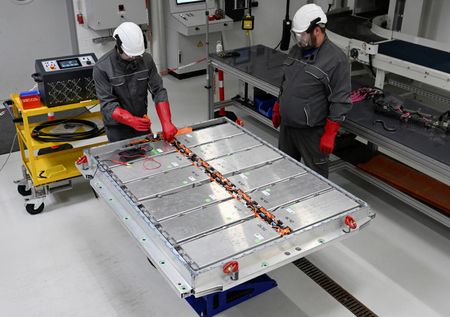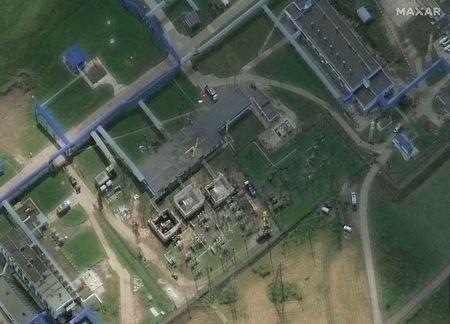By Susanna Twidale
LONDON (Reuters) – Europe’s battery storage capacity is expected to grow around five-fold by 2030, bringing with it increasing returns for energy majors, project developers and traders, as the cost of new projects falls.
Wind and solar use has grown to make up around a third of Europe’s energy mix, but because these renewable sources are intermittent, they have also driven demand for batteries to provide backup.
At the same time, battery technology has made strides, allowing smaller battery packs to store greater amounts of power, dragging down costs.
Even the expected leap in capacity is unlikely to be enough to meet demand to balance national energy grids, according to industry estimates.
Aurora Energy Research forecast capacity will increase to over 50 gigawatts (GW) by 2030, representing investments worth around 80 billion euros ($82.80 billion).
This would still leave a shortfall, compared with expectations from industry group the European Association for Storage of Energy, which estimates 200 GW will be needed by 2030.
Already a record 3.7 GW of projects were added in 2024, taking Europe’s total battery capacity to 10.8 GW, according to data from Aurora Energy Research.
Renewable energy more broadly has left some investors feeling burnt. Technical issues, supply chain problems, rising costs and planning battles have in Europe eaten into the profits of wind turbine makers.
Energy majors have also come under shareholder pressure to return their focus to fossil fuels after the recovery of oil prices following a demand slump caused by pandemic lockdowns.
But battery storage offers multiple ways to make money.
One way is for project operators to secure what are known as ancillary contracts from grid operators that pay them to help balance the system. Capacity market contracts, for instance, pay generators or battery owners to be available when power demand is high.
Now renewable generation is a bigger share of the power mix, price volatility also offers the prospect of rich returns for traders on wholesale energy markets.
At times when more wind or solar is produced than the grid demands, electricity prices have turned negative and battery operators can be paid to store the power for times of need.
“If you can be paid to charge your battery because prices are negative and then sell the electricity at a premium price when the sun goes down at 6 o’clock, then that can be lucrative for traders,” said Roberto Jimenez, executive director at BW ESS, part of global infrastructure firm BW Group.
Data from LSEG shows the number of hours priced at negative or around zero in Britain’s day-ahead electricity market hit a record 176 hours in 2024. It forecasts an almost four-fold increase to 792 hours in 2026.
The picture across Europe is similar. The number of German negative hours is forecast to grow from less than 500 hours in 2024 to above 900 hours in 2026, LSEG forecast.
MAJOR PROFITS
BW ESS has an agreement with oil major Shell for the capacity of a 331 MW battery project in Britain. Under the seven-year agreement, Shell will pay a fixed fee to BW ESS to make the battery available when Shell sees a trading opportunity.
Another major TotalEnergies bought German battery storage company Kyon Energy last year, with the first project from its pipeline, a 200 megawatt-hour project with a 75 million euro investment, due to begin operation in 2026.
A spokesperson for TotalEnergies said the German market has interconnections with 11 countries, providing ample scope for cross-border electricity trading.
New markets are also expected to offer contracted revenues initially to encourage investment. Italy will hold a first auction on battery storage capacity by the end of July 2025, its grid operator Terna said, with the projects expected to be operational in 2028.
Statkraft, Europe’s largest renewable generator, has a large battery portfolio including projects in Britain, Ireland and Germany. It said it may bid into the Italian auction.
RISING RETURNS, SHRINKING COSTS
The growing revenues from trade and contracts have pushed UK battery revenues to their highest level in around two years, RBC analyst Joseph Pepper said, at around 90,000 pounds ($112,617) per MW per year.
At the same time, over-supply from China and as technology improvements shrink the size of battery packs, the price of battery storage has decreased.
Pepper said the cost of building a project in Britain has fallen around 30% in two years to just above 500,000 pounds per MW for a 2-hour duration project.
The result for a British project would be returns of around 12%, he said.
“The key driver we have seen (to improve returns)… is the big decrease and reduction in CAPEX for batteries,” said Tom Vernon, CEO of Statera Energy, which has a pipeline of over 1 GW of projects in operation or construction in Britain.
This trend looks set to continue. Average battery prices fell from $153 per kilowatt-hour (kWh) in 2022 to $149 in 2023 and could fall to as low as $80/kWh by 2026, analysts at Goldman Sachs said.
($1 = 0.9662 euros)
($1 = 0.7992 pounds)
(Reporting By Susanna Twidale; additional reporting by Francesca Landini in Milan, editing by Barbara Lewis)











